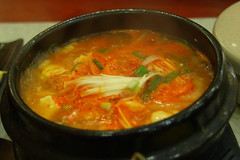Celebrate food, life and diversity. Join me in the search for the right ingredients: Food without human antibiotics, growth hormones and other harmful additives that have become commonplace in animals raised on factory farms.
Attention food shoppers
We are legions -- legions who are sorely neglected by the media, which prefer glorifying chefs. I love restaurants as much as anyone else, but feel that most are unresponsive to customers who want to know how the food they are eating was grown or raised. I hope my blog will be a valuable resource for helping you find the healthiest food in supermarkets, specialty stores and restaurants in northern New Jersey. In the past five years, I stopped eating meat, poultry, bread and pizza, and now focus on a heart-healthy diet of seafood, vegetables, fruit, whole-wheat pasta and brown rice. I'm happiest when I am eating. -- VICTOR E. SASSON
Sunday, January 3, 2010
Gee, what's that in my kimchi?
With the wind howling and temperature falling, is there a better meal than a stone bowl filled with bubbling Korean soft-tofu stew, another bowl of steamed rice and several side dishes? So, last night, right after we placed our order at So Gong Dong in Palisades Park, a waitress brought us four side dishes to quiet our hunger.
We immediately attacked the cabbbage and cucumber kimchis, but my wife and son ignored the other side dishes -- bean sprouts and raw squid in a spicy sauce. Then, my wife's fork uncovered something odd in the cabbage kimchi -- it looked raw, almost rotten. I hit the button on the the table and a chime sounded, summoning a waitress, who said it was just a raw oyster. A raw oyster? My wife was horrified. She hates raw seafood, especially oysters and clams, and refuses even to eat cooked squid or octopus. We gave the waitress our cabbage kimchi and she quickly replaced it and added another dish of cucumber kimchi.
My first taste of kimchi was in the late 1960s, when my Korean roommate at the University of Missouri-Columbia offered me some. Since the late 1990s, I have eaten it regularly at Korean restaurants in North Jersey, including So Gong Dong, and New York City, and now, I always have a bottle of cabbage kimchi in my refrigerator. I have never in all that time seen an oyster in my kimchi. In fact, the only seafood ingredients listed on the label of the Arirang-brand kimchi I often buy in Englewood are salted shrimp and anchovy sauce.
So Gong Dong offers soft-tofu with oysters and may make its own kimchi, so is it possible one of the oysters fell into the kimchi? Or are oysters an ingredient some kimchi-makers add?
Restaurant So Gong Dong, 118 Broad Ave., 2nd Floor,
Palisades Park; 201-313-5550, open seven days.
Subscribe to:
Post Comments (Atom)

![Reblog this post [with Zemanta]](http://img.zemanta.com/reblog_a.png?x-id=8ce967d3-9a7d-4c20-9619-24ba6ec25e4b)
Hi Victor!
ReplyDeleteActually, we have a recipe here that my mother makes that includes whole cabbage and raw oysters. I'm not quite sure if it's a traditionally common kimchi recipe or not, but I've seen it many times in my life. Come on by, and we'll have you try some!
Thank you so much, Victoria. I know there are many kinds of kimchi that I have never encountered. I'd love to try some of your mother's cabbage-oyster kimchi.
ReplyDeleteTo readers: Mrs. Oh's kimchi can be found at Gaboh Inc. in Englewood, home of Arirang-brand kimchi. For the address, just Google "Gaboh Inc."